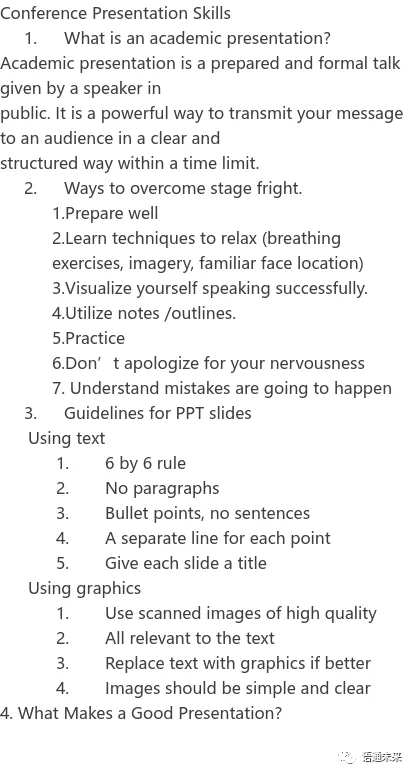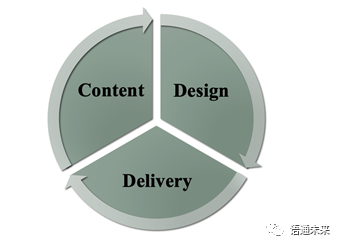Presentation skills (1)
The major characteristics of a good presentation
An academic presentation is a prepared and formal talk given by a speaker in public. It is a powerful way to transmit your message to an audience in a clear and structured way within a time limit. Do you know any of the characteristics of a good presentation?
Actually, a good presentation has many characteristics. The major characteristics are listed below.
A good presentation is accurate. As we know, one of the purposes of making presentations is to convey accurate and concise information about academic studies. To keep the presentation accurate, the presenters may apply some techniques such as using terminology, explaining obscure terms clearly, and reducing vague expressions. If possible, the presenters may use diagrams in the presentation to illustrate their points. And flow charts can also be used in the presentation to describe the complex process. The data reported in the presentation should be concrete, too.
Brevity is the soul of wit. A good presentation is also featured with brevity. A simple and brief presentation can help the audience get the most important points. The presenters can use basic words for profound meanings and lessen slides’ contents and make more oral explanations.
Another characteristic of a good presentation lies in clarity. To a presenter, it means a big failure if the audience cannot remember any of the points presented in the speech. That’s why the presenters try to think of ways to make the contents of the presentation clearly presented. For example, in the presentation, the presenters prefer to choose simpler words and sentences, helping the audience understand the meaning of the presentation as quickly as possible. They also make efforts to reinforce the slide’s attraction, such as making slides easier to follow and just containing the necessary information in the slides.
Accuracy, brevity, and clarity are the major characteristics of a good presentation introduced in this text. Do you know any other characteristics of a good presentation? Share with your peers about these characteristics and then discuss the tips for making the presentation so effective.
Presentation skills (2)


Introducing keynote speakers
1.Introducer to keynote speaker can be the chairperson or a particular person instead.
2.Introduction should cover the keynote speaker’s personal background, education background, academic achievements, awards, and administrative positions if he or she has.
3.Academic achievements involve monographs and articles published as well as patents.
4.Before introducing the keynote speaker, the introducer should make sure that he or she can pronounce the speaker’s name correctly.
5.The moment the introducer finishes his or her introduction, he or she should extend a warm welcome to the keynote speaker.
Keynote speech writing
A keynote speech is an address designed to present the issues of primary interest to an assembly (such as a political convention) and often to arouse unity and enthusiasm. A good keynote speech is inspirational and unifying for its audience.
Before you start writing a keynote speech, you need to know:
-
WHY you are giving a keynote speech (the purpose)
-
WHO you are writing your speech for (the audience)
-
WHAT your speech is going to be about (its topic, main points)
-
HOW long your speech is going to be (its length)
The first step in developing a strong sense of speech organization is to gain command of the three basic parts of a speech—introduction, body, and conclusion—and the strategic role of each.
Your first job in the introduction is to get the attention and interest of the audience. You can do this by posing a question, telling a story, making a startling statement, or opening with a quotation. The purpose of all these methods is to create a dramatic, colorful opening that will make your audience want to hear more. In addition to gaining attention and interest, the introduction should orient your listeners toward the subject matter of your speech.
After getting the audience’s attention and revealing your topic, you are ready to move into the body of your speech. There are many ways to organize the points in a speech. The following strategic orders are commonly used to organize the speech.
-
Chronological Order Speeches arranged chronologically follow a time pattern. They may narrate a series of events, explain a process or demonstrate how to do something.
-
Spatial Order Speeches arranged in spatial order follow a directional pattern, i.e. the main points proceed from top to bottom, left to right, east to west, or some other route.
-
Causal Order You can deal first with the effects and then with the causes.
-
Problem-Solution Order Speeches arranged in problem-solution order are divided into two main parts—the existence and seriousness of a problem and a workable solution to the problem.
-
Topical Order The speech topic is divided into subtopics, each of which becomes a main point in the speech.
When you finish discussing your final point, you will be ready to move onto your conclusion. You need to accomplish two tasks in this part of the speech: let the audience know you are about to finish and reinforce your major theme. You may end your speech with a direct wind-up, a brief summary or solicitation of comments.
References:
- 胡庚申 《国际会议交流》 外语教学与研究出版社 2013
- Lucas, Stephen E. The Art of Public Speaking 10ed. 外语教学与研究出版社 2010
Question and Answer Session
Learning Objectives
-to learn how to handle the question & answer session
-to know tips for facilitating the question & answer session
-to get familiar with the useful expressions
-to succeed in role playing
I. Its importance
-
a short but crucial part of a presentation
-
listeners: get the chance to clarify some parts of the presentation; ask the speaker to expand on some interesting topics
II. Its advantages
-
The message by the speaker is reinforced through the recall of its important points;
-
The audience have a chance to ask and learn more about those aspects in which they are most interested;
-
Speakers can receive valuable feedback information about audience reaction to the speech.
III. How to handle the Q&A session?
-
Prepare well, have a good understanding of your audience and the questions you’ll encounter;
-
Be prepared to wait several seconds for the first question;
-
If silence prevails, break the tension to encourage the audience;
-
Get questions heard and understood by all;
-
For irrelevant questions, quickly dismiss them;
-
Your answers, be direct and to the point;
-
Use printed materials and visual aids, if necessary;
-
For questions you cannot answer, just say “I don’t know”, or ask someone else to answer;
-
Do not allow one person to dominate the session;
-
Conclude the Q&A artistically, keep an eye on the clock.
IV. Q&A Do’s and Don'ts
Do’s
-
Do prepare some questions and answers beforehand;
-
Do address questioners one on one, if possible;
-
Do repeat the question so that all attendees can hear;
-
Do understand the question fully before answering it;
-
Do offer concise and direct answers;
-
Do stay within your own area of expertise;
-
Do apologize for being unable to take every question if you run out of time;
-
Do state your appreciation to close your Q&A;
Don’ts
-
Don’t answer a question that has already been asked;
-
Don’t let a single questioner dominate the Q&A session;
-
Don’t lose your composure;
-
Don’t bluff.
Closing Speech Writing
Definition
A closing speech is a formal talk given by a distinguished guest at the closing ceremony of a conference. Generally speaking, it consists of the basic elements, such as appreciation, summary, evaluation, expectation, invitation and declaration.
Things to Be Done
In a good closing speech, we should at least do the following things:
-
thanking all the related persons and organizations
-
commenting on the contributions of the conference
-
noticing the arrangement for the next conference
-
declaring the conference closed
Typically, the function of closing speeches is to summarize the conference and to motivate participants to take action.
Structure
Based on the function mentioned above, we can divide the closing speech into the 5 sections:
- Gratitude Expression
we may express thanks to keynote speakers, participants, moderator(s), organizer(s), and sponsor(s ).
- Review or Summary
we may review or summarize briefly what has been done at the conference.
- Evaluation
we may evaluate the conference properly on the achievements, significance or influences.
- Invitation
We may extend an invitation to the next conference.
- Declaration
We will declare the closing of the conference.
The closing speech is the last thing that the participants will hear at the conference. Let’s make it impressive and well-organized.
Reference:
贾卫国主编《国际学术交流英语》,北京:外语教学与研究出版社,2018年。